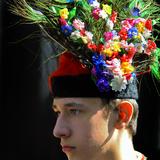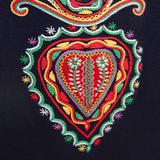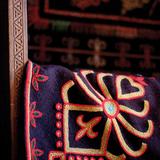Któż nie zna stroju Krakowiaka, z dumnie noszonym na rogatywce pawim piórem, lub góralskiego kapelusza obwiedzionego muszelkami i też ozdobionego piórkiem! Skrzące się cekinami gorsety i grube sznury korali oraz kolorowe spódnice dziewcząt, misternie wyszyte parzenice na góralskich portkach – ludowe stroje w Małopolsce mienią się wyrazistymi barwami i zachwycają różnorodnością wzorów oraz ornamentów. Najbardziej znane są ubiory Krakowiaków z okolic Krakowa oraz górali podhalańskich, lecz nie są to jedyne rodzaje strojów ludowych w regionie. Odmienne było tradycyjne odzienie Łemków i Rusinów z Beskidów Sądeckiego i Niskiego, inaczej także nosili się górale ze Spiszu czy Orawy, jak i Lachowie z ziemi sądeckiej.
Folk costumes Everyone must have seen at one point the famous costume of a Cracovian, with a peacock feather proudly attached to a four-cornered cap, or a highlander’s hat rimmed with shells and adorned with a feather. Richly sequined bodices, thick strings of beads, vividly coloured skirts, meticulously embroidered parzenice on the highlander’s trousers… The folk costumes of Małopolska sparkle with boldest colours and amaze with their variety of design and ornamentation. The most famous folk costumes are worn by the Cracovians and the highlanders from Podhale. Very different traditions were cultivated by the Lemkos and the Rusyns from Beskid Sądecki and the Low Beskids. Still different costumes were worn by the highlanders of Spisz, Orawa and Lachów, near Nowy Sącz.

|
|
The Cracovians are famous for their costumes. The traditional man’s costume consisted of a white linen shirt and red-striped trousers tucked into high boots. The top was a black or dark navy blue tunic, adorned with red weeds and metal circles, girded with a belt and covered with a long, white, woollen russet coat with a red-weed pattern. The costume was complete with a celender hat, a woollen magierka cap or the characteristic red-cornered cap with a peacock feather and colourful ribbons. Women, in turn, used to wear a white embroidered blouse and a black or navy blue bodice, which was the most ornamental element of the costume – adorned with wide, colourful ribbons, buttons and fancywork. They would put on a flowery skirt and a white embroidered tulle apron on a white petticoat, and high boots on their feet. The costume of a married woman was complete with shawls, whereas maidens appeared with their hair uncovered and arranged in a long plait.
|
 |
|
The Lendians inhabit a major part of the Beskids and the area around Nowy Sącz in particular. Their costume is very original, although not very well known – it combines elements of the Kraków and the highlander costumes. It is characterised by its ornamental richness. Men used to wear navy blue trousers and embroidered tunics with numerous brass bosses and coloured woollen weeds. Underneath, they wore a white shirt girded with a wide highlander-style leather belt, or sometimes with a highlander’s stud. Women wore velvet bodices and skirts, usually of navy blue colour.
|

|
|
The Lemkos from the Low Beskids and the Nowy Sącz area created a completely different costume. Men wore the so called czucha – a long, brown linen overcoat with a characteristic fringed back collar. Underneath, they used to put on a short navy blue waistcoat, a white shirt and white trousers. Women, in turn, would wear thin white shirts with colourful embroideries around the collar and the cuffs, navy blue or black bodices with embroidered flower-patterns. The percale skirts were dark and decorated with vertically arranged colourful ribbons. The last component of their costume were kierpce shoes. |
 |
|
The highlanders from Podhale, who live at the foot of the Tatra Mountains, are very proud of their beautiful traditional costume. That is why Podhale is the place where folk costumes are so commonly seen. And a marvellous sight it is, too! Women wear meticulously crafted flat leather shoes (known as kierpce), colourful skirts with a linen apron and a petticoat underneath. A linen shirt with white embroidery is covered with a red or black velvet bodice, often adorned with coloured embroidery presenting a carline or a Turk’s cap lily. Finally, there are the obligatory thick strings of beads and a sheepskin coat for when it gets cold. Men put on a white shirt with an ornamental metal collar stud and a waistcoat called gunia or, alternatively, a loose woollen jacket known as cucha – both ornamentally embroidered. A wide leather belt, which used to serve as a pocket for pistols, holds up the white cloth trousers with a black stripe and the decorative embroideries called parzenice. The costume is complete with the leather kierpce, a cane called ciupaga and a black felt hat adorned with shells and a feather. |
|
|
The highlanders from Pieniny wear a white shirt, a glaring-blue, richly embroidered waistcoat and the traditional white trousers with parzenice. The last necessary element of the costume is a black hat with a little strap imitating a string of shells. In the past, highlanders also used to put on a white or brown embroidered cucha as an overgarment. The traditional woman’s costume was similar to those worn in other regions. Its characteristic elements included a white shirt with a large embroidered collar, a black or red bodice, a flowery skirt, embroidered aprons and the kierpce shoes. |
| |
|
Babiogórcy, the highlanders from the area around Zawoja, used to wear white trousers with much more modest parzenice and brown, knee-long gunie, worn as an overgarment. Women wore navy blue skirts with a little white pattern and the so-called jadwiśka – a close-fitting jacket. On the other side of the Babia Góra mountain, in Orawy, women used to wear elbow-sleeved blouses with a wide lace frill around the cuff and neckline. They also gladly put on bodices and skirts made of the same flower-patterned material. Here men also wore white trousers with parzenice, as well as a black waistcoat with white buttons and a brown gunia. |
| |
|
The highlanders from Spisz, also known as Spiszacy, live east of Podhale. Their costumes vary a lot, even from village to village. However, they used to wear white trousers with parzenice, a waistcoat and a russet coat here as well. Women and girls wore white tops (whose sleeves were often embroidered) and the characteristic bodices with U-shaped necklines. High-top boots were generally preferred to kierpce. |
